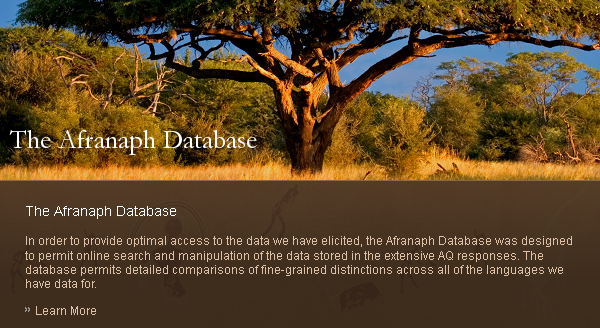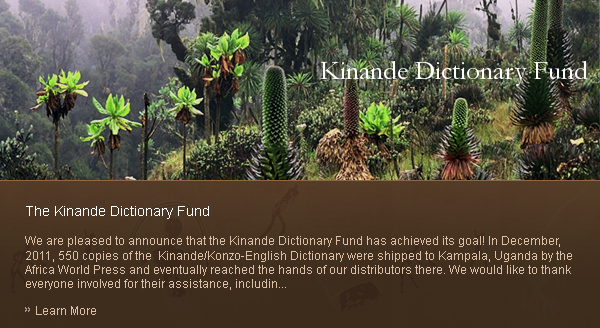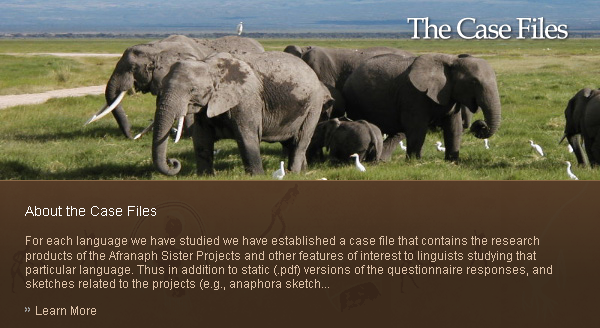- Last Updated on Thursday, 31 August 2023 10:09
![]()
Our elicitations are designed to be highly detailed and specific to portions of grammars that can be compared across a wide range of languages for the purpose of theoretical exploration. Our theoretical bias is toward nativist accounts of language competence; hence we posit a universally available language forming capacity in human beings that operates no differently in Africa than it does anywhere else. From this point of view, even if the world's languages vary enormously, thanks to relatively small formal differences with large effects, or because lexicons and phonological forms must differ, there is still a core plan common to all the world's languages that can most profitably studied by closely studying how they vary. Some impossibilities are common to all the world's languages, for example, hence we are just as interested in what linguistic forms are not possible as we are in what forms are possible. Since our goal is not pedagogy, we may explore constructions that many speakers consider marginal, especially if they sharply distinguish the marginal ones from similar constructions that are completely unacceptable. We fully hope and intend, however, that researchers with goals different from ours may find our data pertinent and accessible.
The Anaphora Questionnaire (AQ) and the Clausal Complementation Questionnaire (CCQ) are designed with every known language in mind and our current understanding of linguistic anaphora and clausal complementation in particular. Thus, the CCQ and that AQ are in no way customized to the effects present in any particular language, but instead address as many interesting questions as we are aware of for the domain of grammar we are studying. The design of the questionnaires will naturally reflect the perspectives of, and serve the research purposes of, those who design them, but as the project develops, questionnaires may be developed by researchers with different perspectives and interests, including our native speaker linguist consultants. Naturally, we expect that our questionnaires will be revised as commentary and experience show their weaknesses (and indeed this has already been the case). Additional questionnaires on other aspects of grammar are part of our plan for the future (The Object Marker Questionnaire, for example).
An important aspect of our methodology is that our questionnaires are designed to be filled out by consultants who are native speakers trained as linguists (at more than rudimentary levels of training). At this point in history, there is an ever-widening pool of potential consultants who fit this description, and so far, the 50 or so linguists who are or have been working with us as consultants are only a small fraction of those we hope to attract.
Working with native speaker linguists permits us to carry on our research through electronic communication, since the sorts of data we are interested in can be harvested by collaborators who know how to treat their own intuitions of acceptability as data. Frequently, native speaker linguist consultants can see what we are trying to find out even if our elicitation is clumsy (either in general or in their language), and so a multitude of elicitation shortcomings are ameliorated by the expertise of those whose data we rely on. Thus, we are counting quite a bit on the linguistic skills and training of those who work with us in order to make this means of harvesting data efficient and insightful.
The latter point is underscored by the fact that our elicitations only begin with the questionnaire. After the questionnaire has been filled out, there ensues a follow-up process with a fair amount of back and forth to clarify the responses and questions. Additional follow-up questions are asked that are designed to explore issues and constructions that can be profitably explored for those domains where one language has a more articulated set of distinctions than others (for example). Thus the presentation of the data contains more than just uniformly complete answers to the questionnaire, and in this respect the character of the follow-up process is partially visible from the commentary that appears directly in the questionnaire responses for each language (particularly in their static .pdf versions, though commentary about each sentence and analytic entity is also found in the database).
When the elicitations are complete, sometimes a sketch of the pattern of anaphora or clausal complementation in the language in question is written up (by the project director, the consultant, or a collaboration between them, or by a collaboration between other project members and the consultant). In the course of working on these essays, often new lines of inquiry open and additional data is entered directly into the database (so not all the information we collect is found in the .pdfs, and certainly none of the analytic entity information).




 Elicitation of Data
Elicitation of Data
